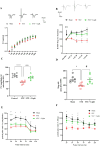40 Hz light preserves synaptic plasticity and mitochondrial function in Alzheimer's disease model
- PMID: 39506052
- PMCID: PMC11541745
- DOI: 10.1038/s41598-024-78528-7
40 Hz light preserves synaptic plasticity and mitochondrial function in Alzheimer's disease model
Abstract
Alzheimer's disease (AD) is the most prevalent type of dementia. Its causes are not fully understood, but it is now known that factors like mitochondrial dysfunction, oxidative stress, and compromised ion channels contribute to its onset and progression. Flickering light therapy has shown promise in AD treatment, though its mechanisms remain unclear. In this study, we used a rat model of streptozotocin (STZ)-induced AD to evaluate the effects of 40 Hz flickering light therapy. Rats received intracerebroventricular (ICV) STZ injections, and 7 days after, they were exposed to 40 Hz flickering light for 15 min daily over seven days. Cognitive and memory functions were assessed using Morris water maze, novel object recognition, and passive avoidance tests. STZ-induced AD rats exhibited cognitive decline, elevated reactive oxygen species, amyloid beta accumulation, decreased serotonin and dopamine levels, and impaired mitochondrial function. However, light therapy prevented these effects, preserving cognitive function and synaptic plasticity. Additionally, flickering light restored mitochondrial metabolites and normalized ATP-insensitive mitochondrial calcium-sensitive potassium (mitoBKCa) channel activity, which was otherwise downregulated in AD rats. Our findings suggest that 40 Hz flickering light therapy could be a promising treatment for neurodegenerative disorders like AD by preserving synaptic and mitochondrial function.
Keywords: Alzheimer’s disease; Flickering 40 Hz white light; LTP; MitoBKCa+2; Mitochondrial function; Mitochondrial metabolites; Synaptic plasticity.
© 2024. The Author(s).
Conflict of interest statement
The authors declare no competing interests.
Figures






Similar articles
-
Grape Seed Proanthocyanidin Extract Ameliorates Streptozotocin-induced Cognitive and Synaptic Plasticity Deficits by Inhibiting Oxidative Stress and Preserving AKT and ERK Activities.Curr Med Sci. 2020 Jun;40(3):434-443. doi: 10.1007/s11596-020-2197-x. Epub 2020 Jul 17. Curr Med Sci. 2020. PMID: 32681248
-
7,8-Dihydroxyflavone improves cognitive functions in ICV-STZ rat model of sporadic Alzheimer's disease by reversing oxidative stress, mitochondrial dysfunction, and insulin resistance.Psychopharmacology (Berl). 2021 Jul;238(7):1991-2009. doi: 10.1007/s00213-021-05826-7. Epub 2021 Mar 27. Psychopharmacology (Berl). 2021. PMID: 33774703
-
The Effect of 40-Hz White LED Therapy on Structure-Function of Brain Mitochondrial ATP-Sensitive Ca-Activated Large-Conductance Potassium Channel in Amyloid Beta Toxicity.Neurotox Res. 2022 Oct;40(5):1380-1392. doi: 10.1007/s12640-022-00565-9. Epub 2022 Sep 3. Neurotox Res. 2022. PMID: 36057039
-
Mitochondrial Dysfunction: a Potential Therapeutic Target to Treat Alzheimer's Disease.Mol Neurobiol. 2020 Jul;57(7):3075-3088. doi: 10.1007/s12035-020-01945-y. Epub 2020 May 27. Mol Neurobiol. 2020. PMID: 32462551 Review.
-
Mitochondrial Dysfunction and Synaptic Transmission Failure in Alzheimer's Disease.J Alzheimers Dis. 2017;57(4):1071-1086. doi: 10.3233/JAD-160702. J Alzheimers Dis. 2017. PMID: 27662318 Free PMC article. Review.
References
-
- Sperling, R. A. et al. Toward defining the preclinical stages of Alzheimer’s disease: Recommendations from the National Institute on Aging-Alzheimer’s Association workgroups on diagnostic guidelines for Alzheimer’s disease. Alzheimers Dement.7 (3), 280–292. 10.1016/j.jalz.2011.03.003 (2011). From NLM. - PMC - PubMed
MeSH terms
Substances
LinkOut - more resources
Full Text Sources
Medical

